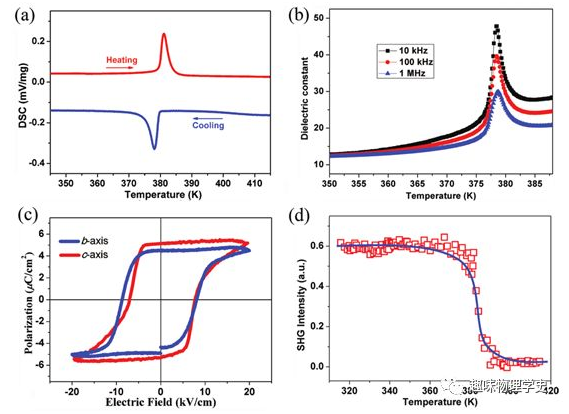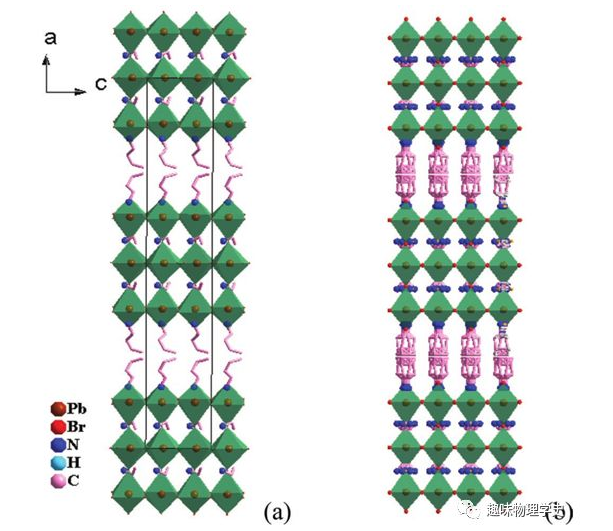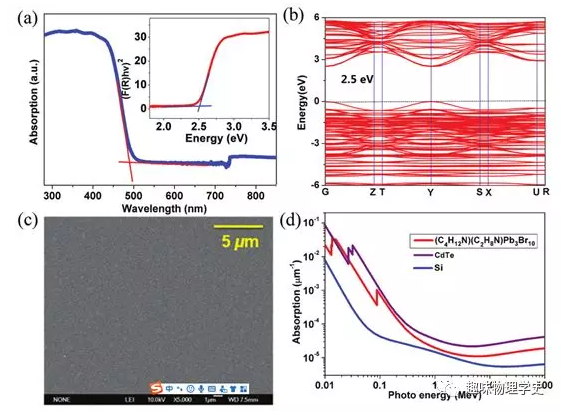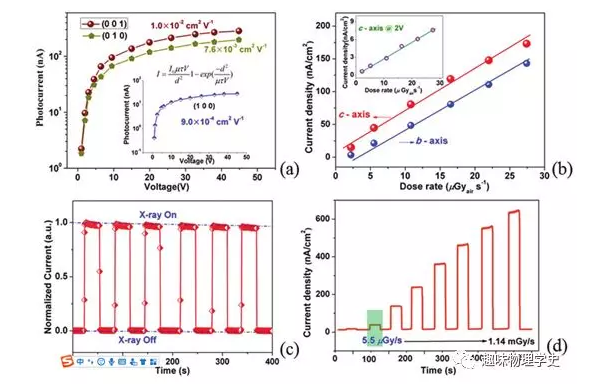Advanced Function Materials: Two-dimensional hybrid perovskite ferroelectrics realize high-sensitivity X-ray detection with low driving voltage
QQ Academic Group: 1092348845
Detailed
Author: Chengmin Ji, Sasa Wang, Yaxing Wang, * Huaixi Chen, Lina Li, Zhihua Sun, Yan Sui, * Shuao Wang, * and Junhua Luo *
Introduction
X-ray detectors with high sensitivity are of great significance in both civil and military fields. In the past few decades, great efforts have been made to improve the sensitivity of conventional inorganic materials, but mainly at the expense of increased energy consumption at a relatively high operating voltage. Considering that the strong ferroelectric spontaneous polarization (Ps) contributes to the separation and transmission of light-induced carriers, it may be a conceptually new strategy to directly develop photosensitive ferroelectrics as detector materials. In this work, a 2D mixed halide perovskite ferroelectric (C4H9NH3)2(C2H5NH3)2Pb3Br10(BA2EA2Pb3Br10) (Ps=5μC cm−2) high-performance X-ray detector was prepared, and it has a high performance of 6.8×103μC Gyair The ultra-high X-ray sensitivity of −1cm−2 is still more than 300 times larger than the latest α-Se X-ray detector at a relatively low working voltage. As a pioneering work, these findings provide information for the exploration of mixed halide perovskite ferroelectrics into high-performance optoelectronic devices.
Graphic introduction

a) Thermal properties measured by DSC. b) Dielectric constant with variable temperature. c) The hysteresis loop of the polarization electric field (PE) along the b-axis and c-axis. d) Temperature dependence of SHG signal.

Comparison of the crystal structure of BA2EA2Pb3Br10 in the paraelectric and ferroelectric phases. The filled view of BA2EA2Pb3Br10 at a) 270 K and b) 385 K, projected along the b axis. For clarity, the hydrogen atom is omitted.

a) The absorption spectrum of BA2EA2Pb3Br10. Illustration: Calculating the optical band gap using the Tauc method. b) The calculated energy band structure of BA2EA2Pb3Br10. c) SEM image of single crystal surface. d) The relationship between the absorption coefficient of BA2EA2Pb3Br10, CdTe and Si and the photon energy.

a) The bias-dependent photoconductivity of BA2EA2Pb3Br10. The Hecht equation was applied to fit the photoconductivity data. b) Photocurrent generated by X-rays at various dose rates under a bias of 10 V. c) The relationship between photocurrent and time of photodetector. d) BA2EA2Pb3Br10 with variable dose rate photocurrent versus time
in conclusion
In conclusion, this work successfully proposed a novel two-dimensional three-layer hybrid perovskite ferroelectric BA2EA2Pb3Br10, which has high Curie temperature and outstanding spontaneous polarization characteristics, and exhibits fascinating ferroelectricity. It is emphasized that the excellent ferroelectric performance is an important reason for the great migration life (μτ), which makes BA2EA2Pb3Br10 a high-performance X-ray detector. The single crystal X-ray detector of BA2EA2Pb3Br10 exhibits an ultra-high sensitivity of 6.8×103μC Gyair−1cm−2 and a low detection limit of 5.5μGyair s-1 at low voltage, which is crucial for the potential applications of optoelectronic devices. These results provide the first example of hybrid ferroelectrics as high-performance X-ray detectors, which are expected to stimulate further exploration of new types of ferroelectrics for diversified applications.
author information
C. M. Ji, S. S. Wang, H. X. Chen, Dr. L. N. Li, Prof. Z. H. Sun,
Prof. J. H. Luo
State Key Laboratory of Structural Chemistry
Fujian Institute of Research on the Structure of Matter
Chinese Academy of Sciences
Fuzhou, Fujian 350002, P. R. China
Dr. Y. X. Wang, Prof. S. A. Wang
School for Radiological and Interdisciplinary Sciences (RAD-X)
and Collaborative Innovation Center of Radiation Medicine
of Jiangsu Higher Education Institutions
Soochow University
Suzhou 215123, China
Prof. Y. Sui
Key Laboratory of Coordination Chemistry of Jiangxi Province
School of Chemistry and Chemical Engineering
Jianggangshan University
Ji’An, Jiangxi 342009, China
Introduction
X-ray detectors with high sensitivity are of great significance in both civil and military fields. In the past few decades, great efforts have been made to improve the sensitivity of conventional inorganic materials, but mainly at the expense of increased energy consumption at a relatively high operating voltage. Considering that the strong ferroelectric spontaneous polarization (Ps) contributes to the separation and transmission of light-induced carriers, it may be a conceptually new strategy to directly develop photosensitive ferroelectrics as detector materials. In this work, a 2D mixed halide perovskite ferroelectric (C4H9NH3)2(C2H5NH3)2Pb3Br10(BA2EA2Pb3Br10) (Ps=5μC cm−2) high-performance X-ray detector was prepared, and it has a high performance of 6.8×103μC Gyair The ultra-high X-ray sensitivity of −1cm−2 is still more than 300 times larger than the latest α-Se X-ray detector at a relatively low working voltage. As a pioneering work, these findings provide information for the exploration of mixed halide perovskite ferroelectrics into high-performance optoelectronic devices.
Graphic introduction

a) Thermal properties measured by DSC. b) Dielectric constant with variable temperature. c) The hysteresis loop of the polarization electric field (PE) along the b-axis and c-axis. d) Temperature dependence of SHG signal.

Comparison of the crystal structure of BA2EA2Pb3Br10 in the paraelectric and ferroelectric phases. The filled view of BA2EA2Pb3Br10 at a) 270 K and b) 385 K, projected along the b axis. For clarity, the hydrogen atom is omitted.

a) The absorption spectrum of BA2EA2Pb3Br10. Illustration: Calculating the optical band gap using the Tauc method. b) The calculated energy band structure of BA2EA2Pb3Br10. c) SEM image of single crystal surface. d) The relationship between the absorption coefficient of BA2EA2Pb3Br10, CdTe and Si and the photon energy.

a) The bias-dependent photoconductivity of BA2EA2Pb3Br10. The Hecht equation was applied to fit the photoconductivity data. b) Photocurrent generated by X-rays at various dose rates under a bias of 10 V. c) The relationship between photocurrent and time of photodetector. d) BA2EA2Pb3Br10 with variable dose rate photocurrent versus time
in conclusion
In conclusion, this work successfully proposed a novel two-dimensional three-layer hybrid perovskite ferroelectric BA2EA2Pb3Br10, which has high Curie temperature and outstanding spontaneous polarization characteristics, and exhibits fascinating ferroelectricity. It is emphasized that the excellent ferroelectric performance is an important reason for the great migration life (μτ), which makes BA2EA2Pb3Br10 a high-performance X-ray detector. The single crystal X-ray detector of BA2EA2Pb3Br10 exhibits an ultra-high sensitivity of 6.8×103μC Gyair−1cm−2 and a low detection limit of 5.5μGyair s-1 at low voltage, which is crucial for the potential applications of optoelectronic devices. These results provide the first example of hybrid ferroelectrics as high-performance X-ray detectors, which are expected to stimulate further exploration of new types of ferroelectrics for diversified applications.
author information
C. M. Ji, S. S. Wang, H. X. Chen, Dr. L. N. Li, Prof. Z. H. Sun,
Prof. J. H. Luo
State Key Laboratory of Structural Chemistry
Fujian Institute of Research on the Structure of Matter
Chinese Academy of Sciences
Fuzhou, Fujian 350002, P. R. China
Dr. Y. X. Wang, Prof. S. A. Wang
School for Radiological and Interdisciplinary Sciences (RAD-X)
and Collaborative Innovation Center of Radiation Medicine
of Jiangsu Higher Education Institutions
Soochow University
Suzhou 215123, China
Prof. Y. Sui
Key Laboratory of Coordination Chemistry of Jiangxi Province
School of Chemistry and Chemical Engineering
Jianggangshan University
Ji’An, Jiangxi 342009, China
- Previous: Huang Peng Biomaterial
- Next: A Rising 2D Star: Nove


 Academic Frontier
Academic Frontier
